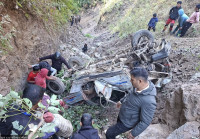National
Beneficiaries of free electricity decline as people increase power consumption
Households consuming less than 20 units with five-ampere metres benefit from the scheme.
Prithvi Man Shrestha
The number of beneficiaries who don’t need to pay electricity tariff has fallen by around three hundred thousand in the last few months, a senior official of Nepal Electricity Authority said.
As per the government’s policy, the Electricity Authority does not charge any tariff on households who consume less than 20 units a month with five-ampere metres. They, however, have to pay a minimum service charge of Rs30 per month.
“There are around 1.7 million households that don’t have to pay any tariff except the service charge,” said Manoj Silwal, chief of the distribution and consumer service directorate of the state-owned power utility. “The number changes every month and there has been a sharp reduction.”
It is a sharp drop from around two million beneficiaries the NEA recorded in the last fiscal year 2021-22.
According to the NEA’s Annual Report 2021-22, approximately 2 million domestic consumers with five-ampere metres got free energy in the last fiscal year. The state-owned power utility said it distributed 85.99 million units of electricity to such consumers in the last fiscal year.
According to the NEA, there are a total of 4.76 million consumers, including both commercial and household. It means, around 36 percent of total consumers are benefiting from tariff exemptions.
“The main reason behind the decrease in the beneficiaries of free electricity is that the consumers in that category have been increasing electricity consumption possibly due to improved living standards,” said Silwal. “The decrease in their number means it has also contributed to the rise in the revenue of the NEA.”
According to him, the growing trend of using more and more electric and electronic goods among the people also contributed to the rise in household electricity consumption.
The NEA has also promoted the greater consumption of electricity by upgrading people’s five-ampere metres with 15 metres free of cost.
“Even in the Kathmandu Valley, there are still a large chunk of households who are using five-ampere metres and many households have been upgrading to 15-ampere metres,” said Silwal.
The government had announced through the budget for fiscal year 2020-21 that it would provide free electricity to the households whose monthly power consumption is up to 10 units.
In August last year, Energy Minister Pampha Bhusal announced the plans to provide free electricity for households consuming less than 20 units per month.
Starting from November last year, the Electricity Regulatory Commission implemented a revised tariff plan including a free electricity plan for households consuming less than 20 units in a month.
With power production in the country on the rise, the NEA also aims to increase the consumption of electricity by both households and commercial consumers.
According to the NEA, installed capacity of power projects in the country stands at 2268MW as of last fiscal year end while the peak domestic demand for electricity is around 1800MW in normal times.
After elimination of load shedding, the NEA has shifted its priority towards the supply of safe and reliable electricity to its consumers. In addition to this, service delivery improvement, automation of the distribution system, electricity access to every household are also the major objectives, according to the NEA.
The power utility aims to increase per capita power consumption to 400 units per annum by the end of current fiscal year 2022-23. According to the Ministry of Energy, Water Resources and Irrigation, per capita energy consumption in the country stands at 350 units as of last fiscal year 2021-22.
Achyut Babu Ghimire, director at the distribution and consumer service directorate, said that NEA aimed to increase per capita consumption of electricity to boost power consumption amid rising power production in the country.




 9.12°C Kathmandu
9.12°C Kathmandu















